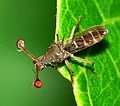Eyestalk
Jump to navigation
Jump to search

In anatomy, an eyestalk (sometimes spelled eye stalk and also known as an ommatophore) is a protrusion that extends an eye away from the body, giving the eye a better field of view.[1] It is a common feature in nature and frequently appears in fiction.[2]
In nature
Eyestalks are a specialized type of tentacle. Tentacles may also have olfactory organs at their ends.[3] Examples of creatures with olfactory tentacles include snails, the trilobite superfamily Asaphida, and the fly family Diopsidae. In slugs and snails, these tentacles will regrow if severely damaged, and in some species, are retractable.[1] Crustaceans also have eyestalks, consisting of two segments. [4]
Gallery
-
Eyestalk of a lobster.
See also
- Eyestalk ablation
- The cephalofoils of Hammerhead sharks
References
- ^ a b c "Slug and Snail Anatomy". All About Slugs. Retrieved 7 December 2015.
- ^ Allayie SA, Ravichandran S, Bhat BA. Hormonal regulatory role of eyestalk factors on growth of heart in mud crab, Scylla serrata. Saudi J Biol Sci. 2011;18(3):283-286. doi:10.1016/j.sjbs.2011.02.003
- ^ "Snails and Slugs (Gastropoda) – The Tentacles of Snails". The Living World of Molluscs. Retrieved 8 December 2015.
- ^ Powar, C. B. (1969). "Musculature of the Eyestalk in Crustacea". Acta Zoologica: 127. Retrieved 17 August 2020.


